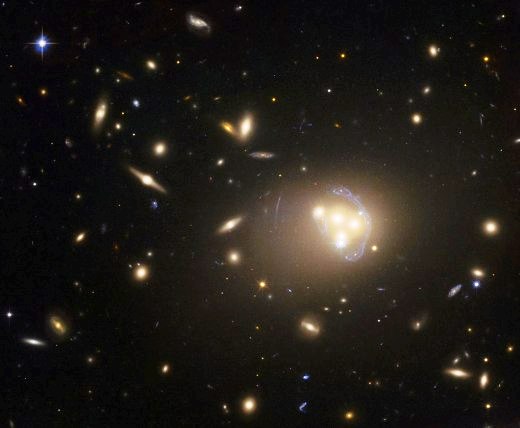Researchers recently observed four colliding galaxies and found that one clump of dark matter appeared to be lagging behind the galaxy it surrounds. Why is that significant?
Well read on.
Dark matter remains a mystery to scientists, for they are still struggling to come to terms with what it actually does. For the first time, it might have been observed interacting with other dark matter in a way other than through the force of gravity. How? What does this mean?
![hubble-telescope-photos[1]](https://amazingstories.com/wp-content/uploads/2015/06/hubble-telescope-photos1-e1433422939230.jpg) To begin, a team of astronomers used the combined resources of the European Southern Observatory’s (ESO) Very Large Telescope (VLT) and the NASA/ESA Hubble Space Telescope to study the simultaneous collision of four galaxies in the galaxy cluster Abell 3827. Doing so allowed the team to trace out where the mass lies within that system and compare the distribution of the dark matter with the positions of other luminous galaxies. As they did so, they picked up some intriguing hints that might help us.
To begin, a team of astronomers used the combined resources of the European Southern Observatory’s (ESO) Very Large Telescope (VLT) and the NASA/ESA Hubble Space Telescope to study the simultaneous collision of four galaxies in the galaxy cluster Abell 3827. Doing so allowed the team to trace out where the mass lies within that system and compare the distribution of the dark matter with the positions of other luminous galaxies. As they did so, they picked up some intriguing hints that might help us.
Although dark matter cannot be seen, you can determine its location by using a technique called gravitational lensing. In this case, the team happened to spot the fact that the collision they were monitoring took to place directly in front of a much more distant, unrelated source. Further examination determined the mass of dark matter around the colliding galaxies severely distorted space-time, deviating the trajectory of light rays coming from that distant background galaxy and distorting its image into characteristic arc shapes.

This image from the NASA/ESA Hubble Space Telescope helps explain things. It shows the awesome galaxy cluster Abell 3827. The strange pale blue structures surrounding the central galaxies are gravitationally lensed views of a much more distant galaxy behind the cluster.
Take a closer look. The distribution of dark matter in the cluster is shown with blue contour lines. The dark matter clump for the galaxy on the left is significantly displaced from the actual position of the galaxy itself, implying a dark matter to dark matter interaction is taking place.
Our current understanding is that all galaxies exist inside clumps of gravitational dark matter. Without the constraining effect of dark matter, galaxies like the Milky Way would fling themselves apart as they rotate. In order to prevent this, 85% of the universe’s mass must exist as dark matter, and yet its true nature still remains a mystery.
In this case study, the researchers observed the four colliding galaxies and found that one of the dark matter clumps appeared to be lagging behind the galaxy it surrounds – about 5,000 light-years behind. Such a thing has never been seen to occur before, even in the analysis of 72 other galaxy collisions.
Richard Massey from Durham University in England was quoted as saying, “We used to think that dark matter just sits around, minding its own business, except for its gravitational pull. But if dark matter were being slowed down during this collision, it could be the first evidence for rich physics in the dark sector — the hidden universe all around us.”
Obviously further investigation will be needed to study other effects that could also produce a lag. Nevertheless, this is exciting news. Why?
“We know that dark matter exists because of the way that it interacts gravitationally, helping to shape the universe, but we still know embarrassingly little about what dark matter actually is,” said Liliya Williams of the University of Minnesota. “Our observation suggests that dark matter might interact with forces other than gravity, meaning we could rule out some key theories about what dark matter might be.”
The fact of the matter is, dark matter interacts very little with itself. But this new observation concentrated on the motion of individual galaxies as opposed to clusters of galaxies. Researchers commented that the collision between the 4 galaxies mentioned could have lasted longer than the collisions observed in the previous study, thereby allowing the effects of even a tiny frictional force to build up over time and create a measurable lag.
Taken together, the two results focus more precisely on the behaviour of dark matter for the first time, and who knows what else that might lead to?
Food for thought perhaps, for those like me whose minds journey the stars without a spaceship on a regular basis.
Until next time – therapy allowing










